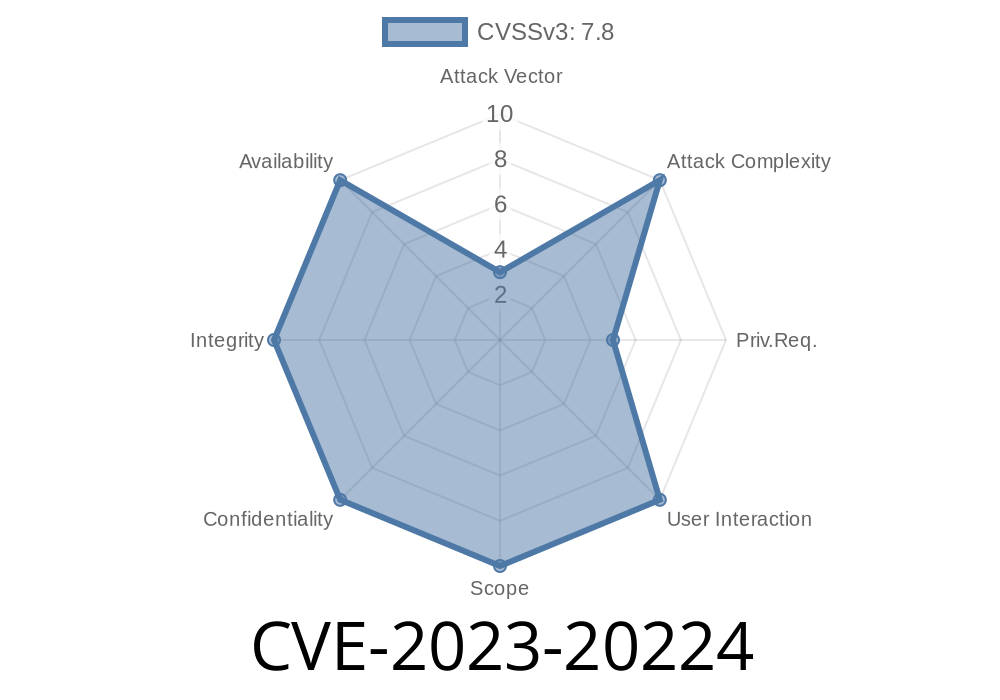---
Introduction
In March 2023, Cisco disclosed CVE-2023-20224 – a privilege escalation vulnerability in the Command-Line Interface (CLI) of Cisco ThousandEyes Enterprise Agent, specifically the Virtual Appliance installation. While only users with valid credentials can exploit this vulnerability, gaining root on enterprise-monitoring appliances can open doors to sensitive data and internal pivots for attackers. In this post, we'll break down how the bug works, show you a simplified exploit example, and share mitigation tips.
What Is Cisco ThousandEyes Enterprise Agent?
Cisco ThousandEyes is a network and application performance monitoring platform. The Enterprise Agent is deployed in virtualized environments to monitor network health across organizations.
What’s CVE-2023-20224?
The vulnerability lies in the CLI binary installed on the ThousandEyes Agent Virtual Appliance. Due to insufficient validation of CLI arguments, an authenticated, local user can inject arbitrary operating system commands, which are then executed as root. Remote attackers cannot exploit this bug without valid credentials.
Threat: Privilege escalation (local user to root)
- CVSS Score: 7.8 (High) – see NVD entry
How Does the Exploit Work?
Under the hood, the CLI management interface fails to properly sanitize user-supplied inputs. If a user is able to login and access the CLI, they can abuse certain arguments or commands to inject extra shell syntax, causing arbitrary code to execute as root.
Suppose, for example, a CLI command internally builds a shell command like
import os
def run_command(user_arg):
os.system("some_tool --option %s" % user_arg)
If user_arg is not properly validated or quoted, an attacker might enter ; id ; and execute the harmless id command with root privileges.
(Disclaimer: For educational purposes only.)
Suppose, a legitimate user logs in to the Cisco ThousandEyes Enterprise Agent and is dropped to its CLI menu. The menu includes an option to run tools with user input:
thousandeyes-agent> run-tool ping 8.8.8.8
If there’s inadequate input sanitation, what happens if you do
thousandeyes-agent> run-tool ping 8.8.8.8; id; whoami
On the back-end, the code might naively execute
os.system("ping %s" % user_input)
So, if user_input is 8.8.8.8; id; whoami, the effective shell command is
ping 8.8.8.8; id; whoami
Output
uid=(root) gid=(root) groups=(root)
root
The output shows that arbitrary commands have executed as root. An attacker can now easily escalate to full root access.
Here's how an exploit could look in Python-like pseudo-code
import pty
import os
# Simulate logging in as a regular user
def exploit():
# Spawn a shell that would run as root due to the faulty CLI
try:
# Replace with the real CLI process name
pty.spawn("/usr/bin/thousandeyes-agent-cli")
# At the prompt, inject via run-tool or similar vulnerable items
os.system('run-tool traceroute 127...1; id; whoami')
except Exception as e:
print(e)
exploit()
Of course, the actual CLI command names and exploit steps may differ, as Cisco does not disclose the exact spots for security reasons. But the core problem is unescaped input landing in root-executed shell commands.
Cisco addressed this issue in March 2023. Here’s what you should do
- Update your ThousandEyes Agent appliances.
References
- Cisco Advisory for CVE-2023-20224
- NVD Entry
- ThousandEyes Agent Documentation
Conclusion
CVE-2023-20224 is a textbook example of why input validation is mission-critical, especially in root-level CLI tools. If you run Cisco ThousandEyes Enterprise Agent, make sure you're on the latest version. Limiting device access to trusted admins and performing regular security reviews can minimize your risk from similar vulnerabilities.
Stay safe, patch frequently, and never trust user input!
*This post is exclusive content from an independent infosec writer, designed to help IT admins understand and defend against real-world privilege escalation threats on Cisco devices.*
Timeline
Published on: 08/16/2023 22:15:11 UTC
Last modified on: 08/25/2023 17:52:52 UTC
